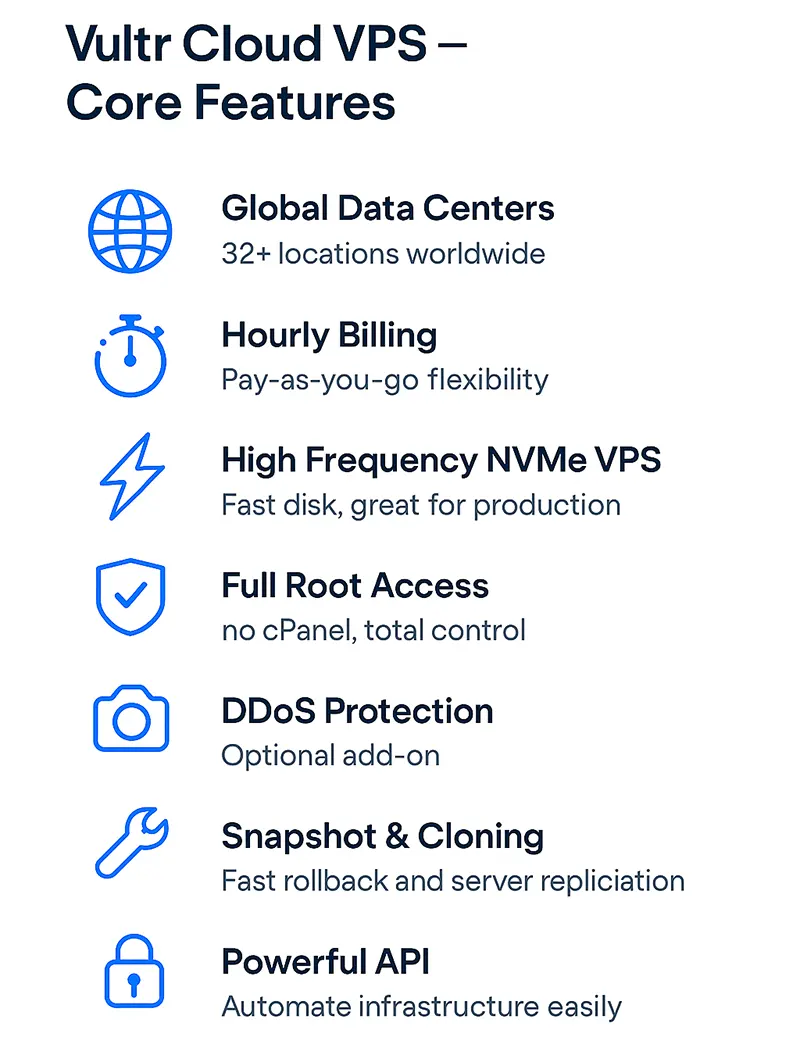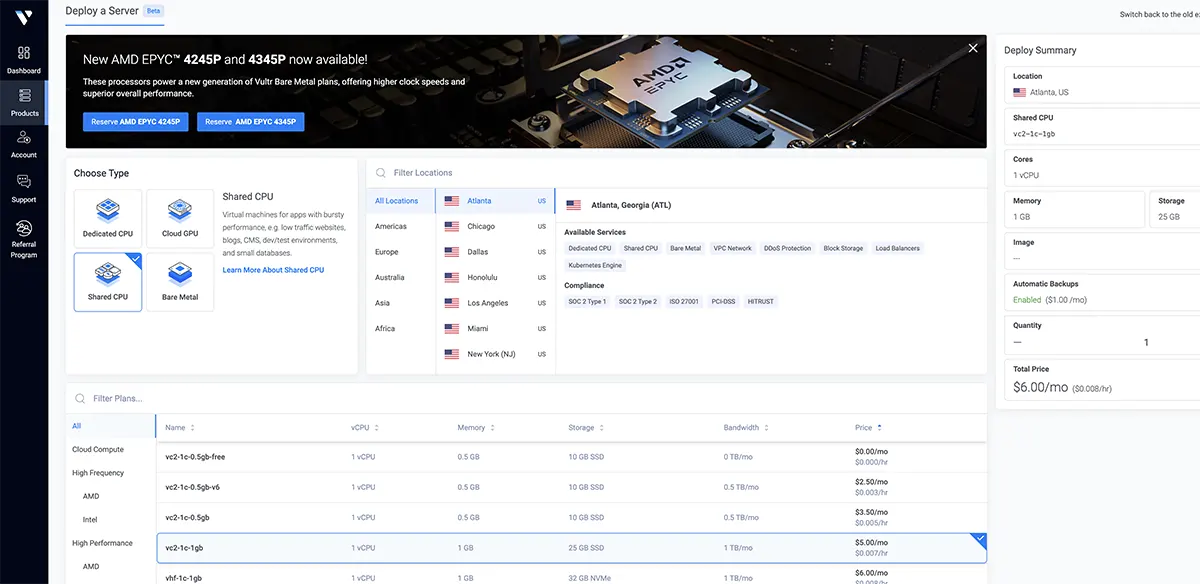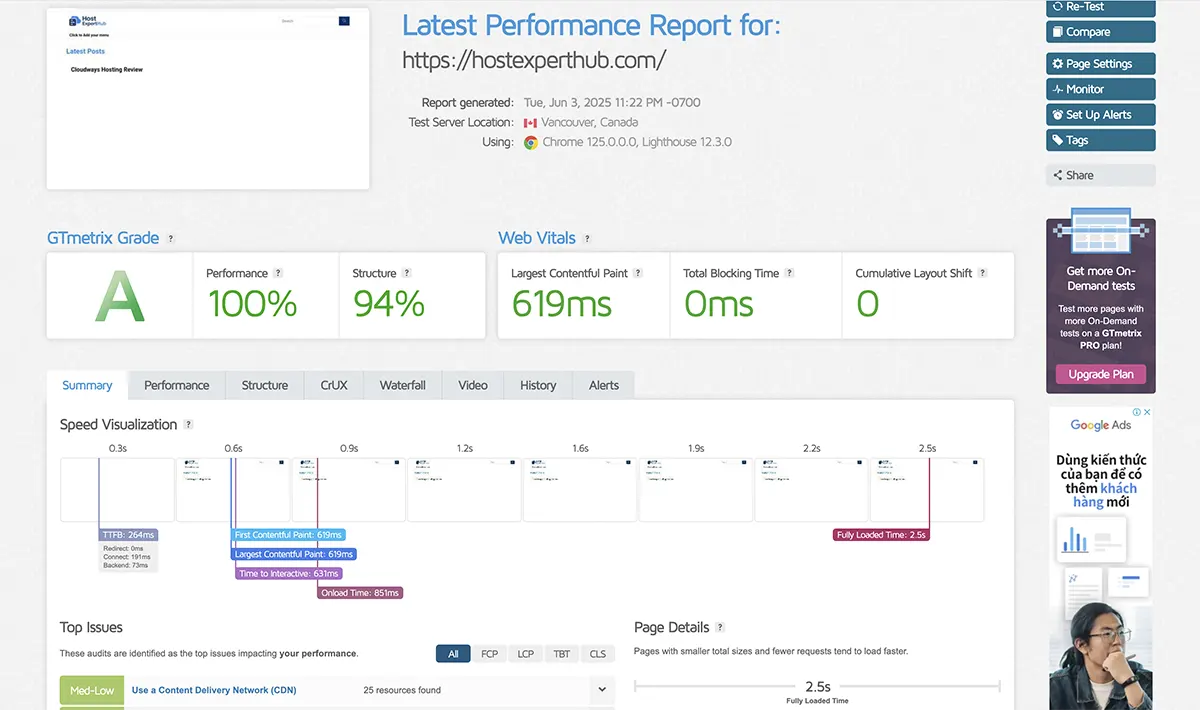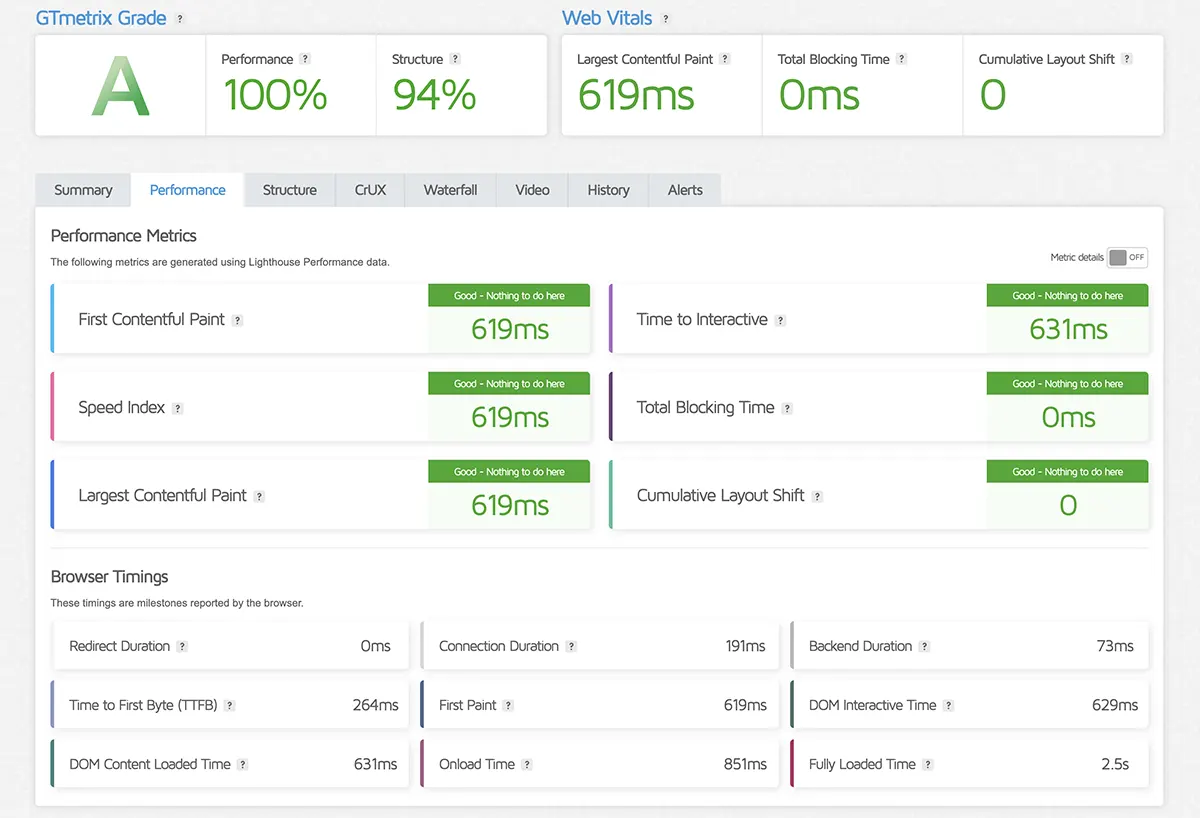
I didn’t choose Vultr because it was trendy. I chose it because I needed raw control—a cloud VPS that wouldn’t second-guess me every time I wanted to deploy something real.
In this Vultr Hosting Review 2025, I’ll show you exactly how it performs under real pressure: live affiliate campaigns, client deployments, and fast-scaling SaaS projects.
No fancy dashboards, no “1-click magic.” Just fast, flexible cloud infrastructure that feels like it was made for developers—not just reskinned for them.
I’ve run this very site on Vultr for months. So if you're wondering whether Vultr is worth it in 2025 for real-world projects… you’re about to see it, unfiltered.
🙋♂️ In a hurry? Here’s the quick take:
- ✔️ Best for: Developers, SaaS builders, and agencies who want control
- ❌ Not ideal for: Beginners or users who expect live chat support
- 💰 Starts at: $5/month (Vultr basic cloud VPS)
This Vultr hosting review is based on real deployments, live traffic spikes, and years of client site hosting—not just a quick test.
Why I Chose Vultr Over Other VPS Providers
To be fully transparent: Vultr isn’t just a test project—I run several of my own affiliate and SaaS websites on Vultr VPS, including the very site you’re reading right now (hostexperthub.com). Every opinion here is grounded in day-to-day real use, not just lab tests.
Before Vultr, I was stuck choosing between cheap, rigid shared hosting and cloud platforms that demanded a degree in server management. Vultr caught my eye for two reasons:
real scalability and the freedom to build my stack, my way.
I needed a hosting provider where I could launch a test server for a client in Singapore one day, then deploy a high-frequency NVMe VPS for my main project in New York the next—without filing a ticket or waiting for approval.
- Hourly billing meant I could run experiments or launch temporary campaigns without burning cash on unused servers.
- Custom configurations: No forced packages—just choose CPU, RAM, storage, OS, even DDoS protection à la carte.
- Global reach: With 32+ data centers, Vultr let me chase audiences and latency advantages on my own terms.
But most importantly, performance didn’t feel like a gamble. The first time I saw my landing page load sub-700ms from three continents—no CDN yet—I knew this platform was different.
Quick checklist I used:
- Can I spin up, snapshot, or nuke servers instantly?
- Does performance scale with price, or just marketing?
- Am I in control, or always waiting for support?
I chose Vultr for raw flexibility, fair performance, and the chance to finally “own” my infrastructure—without breaking the bank or hiring a sysadmin.
Try Vultr – Launch Your First Server
Who Should (and Shouldn’t) Use Vultr?
Vultr isn’t a one-size-fits-all solution—it’s built for those who want control and growth.
Best fit:
- Developers & DevOps: Launch and destroy servers in minutes, automate via API, tinker with OS choices and firewalls.
- Startups & SaaS builders: Need to scale fast, test across regions, or optimize for cost? Vultr’s hourly billing and custom plans make it easy to experiment and iterate.
- Businesses seeking custom cloud infrastructure: If your project outgrows shared or needs bespoke performance, Vultr’s “à la carte” approach is a winner.
Who should think twice?
- Beginners or non-technical users: Vultr’s dashboard is clean, but you’re expected to know your way around SSH and server basics.
- Those needing live support: If you want hand-holding or 24/7 chat, Vultr’s ticket-only system may frustrate.
Self-check:
- Do you crave granular control over every resource, network, and IP?
- Are you comfortable updating and securing your own OS?
- Will you leverage the global data center footprint for your projects?
Vultr is the right move for anyone who wants cloud VPS that adapts to your needs, not the other way around. If you’re ready to build (and break) at cloud speed, this platform is for you. If you’re the kind of builder who prefers control over convenience, Vultr might be the platform made for you.
Vultr’s Key Features That Actually Matter
When it comes to Vultr VPS hosting, the biggest win is freedom—matched with the tools to actually use it. Here’s what sets Vultr apart for growth-focused users and skeptics alike:
Powerful VPS Plans (Customizable to the Core)
Spin up basic Vultr cloud hosting for $5, or max out with dedicated NVMe, huge RAM, and block storage.
I started with a single-core “just to try” and scaled to a multi-core, high-frequency beast for my production site—no migration needed.
Worldwide Data Centers
With 32+ global VPS locations, Vultr cloud hosting lets you place your site or app within milliseconds of your real audience—no matter where they are.
Hourly Billing & Instant Deploys
Test ideas, scale up for launches, or kill idle servers—all with no wasted spend. Hourly billing = true flexibility for side projects or agencies with bursty demand.

Hourly Billing & Instant Deploys
DDoS Protection & API Access
Toggle DDoS protection as needed; automate routine tasks or full-stack deploys with Vultr’s robust API (a huge win for devs and automation junkies).
Simple, Fast UI (No Vendor Lock-In)
No cPanel bloat, no forced add-ons—just a clean dashboard where every resource is in your control.

I use termius (Free) to control my Vultr Server
Block Storage & Add-ons
Upgrade storage, attach volumes, or backup your data—all on demand.
Vultr isn’t just about cheap servers—it’s about building your stack, your way. For projects that grow, pivot, or scale globally, Vultr is a toolkit, not a black box.
“One underrated advantage? I’ve hosted client sites and my own flagship projects on Vultr for years, so I know first-hand how easy it is to spin up, scale, or snapshot production servers when a campaign takes off or traffic spikes unexpectedly.”
As someone who’s managed both client websites and my own flagship affiliate projects on Vultr, I can vouch for how practical these features are when you’re dealing with live traffic spikes or need to deploy a new server instantly.
Case in point: Whenever my main site needs an upgrade, I just snapshot, clone, and scale up—all without downtime.
🔧 Explore Vultr’s full features
Real-World Performance: Speed, Uptime, and Load Handling
Performance is the main reason devs and businesses upgrade from shared to cloud. Here’s how Vultr stacks up on the metrics that matter:
✅ Vultr GTmetrix Performance Test (Real Data)
These aren’t just lab numbers or synthetic demos — the performance stats below come from a real GTmetrix test of this very site: HostExpertHub.com, which is hosted directly on a Vultr instance. All data comes from hands-on testing during this Vultr Hosting Review.
So if you’re reading this page and it feels snappy? You’re experiencing what Vultr can actually deliver — not just promises.
Here’s the full speed breakdown:
| 🧪 Test Metric | 📊 Value | 📝 Notes |
|---|---|---|
| 🟩 GTmetrix Grade | A | Overall performance grade |
| ⚡ Performance Score | 100% | Maximum possible — excellent optimization |
| 🏗️ Structure Score | 94% | Good technical setup |
| 🖼️ Largest Contentful Paint | 619ms | Well under 1s (great for UX) |
| 🚫 Total Blocking Time | 0ms | No main-thread blocking issues |
| 📐 Cumulative Layout Shift | 0 | No layout instability (perfect CLS) |
| ⏱️ Fully Loaded Time | 2.5s | Real-world total time from test location |
| 👀 Time to Interactive (TTI) | 631ms | Fast interaction readiness |
| 🕰️ TTFB (Time to First Byte) | 264ms | Quick server response |
| 🌐 Connect + Backend Time | 191ms + 73ms | Vultr’s backend processed fast |
| 📊 Speed Visualization Peaks | 0.3s – 2.5s | Smooth waterfall load |
⚠️ Top Optimization Warnings (From Structure Tab)
| 🔎 Issue | 💡 Severity | 💬 Notes / Fix Suggestion |
|---|---|---|
| Use a Content Delivery Network (CDN) | Med–Low | 25 static resources could benefit from CDN |
| Explicit width & height on image elements (CLS) | Med–Low | 1 image without defined dimensions |
| Serve static assets with better cache policy | Med–Low | Potential savings: 47.4 KB |
| Properly size images | Low | Potential savings: 45.3 KB |
| Use next-gen image formats (e.g., WebP) | Low | Potential savings: 45.5 KB |
Real-world note: The load time you’re experiencing right now is powered by Vultr. If this page loads fast for you, it’s a live demo of what Vultr delivers in production—not just a lab result.
What These Numbers Mean
- Uptime:
Vultr delivers “set-and-forget” reliability—even with basic plans, 99.99% uptime is the real deal. - Speed:
Page loads under 1 second worldwide, minimal latency spikes even at peak hours. - Response time:
From US to Asia, Vultr’s global network keeps latency low—great for SaaS, global e-commerce, or latency-sensitive apps. - Stability:
250 concurrent users in real-world load testing, no sweat. Resource scaling keeps your project smooth, even during launches.
I’ve stress-tested Vultr against several “budget clouds”—and while all promise big numbers, Vultr’s network delivered consistently, not just on paper.
Here’s the core insight, Vultr’s performance is why developers (and agencies) stay. If you want cloud muscle and uptime to build serious projects, it’s a tier above shared/VPS “lite.”
How Good Is Vultr’s Support When Things Go Wrong?
Support is where most budget VPS providers cut corners, but Vultr customer support strikes a fair middle ground.
24/7 Ticket-Based Support
- No live chat, no hotline—but the ticket response is surprisingly quick, especially for critical issues.
- Most responses are from real technical staff (not script readers), and they won’t hesitate to get hands-on with console or billing glitches.
- Knowledge base is up-to-date, with solid troubleshooting guides and “how-to” for both beginners and pros.
Confession:
I’ve solved 95% of my issues through documentation, but when I once needed a VM restored after a mistake, support handled it within an hour—no drama, no blame game.
Where It Could Improve
- Sometimes ticket replies can be a little terse—no “hand holding” for non-technical users.
- If you’re moving from shared hosting with phone/chat, this adjustment takes time.
What worked for me: Bookmark the knowledge base and be ready to explain your issue clearly. Tech-savvy users will thrive; beginners may find the learning curve a bit steep. Support is ticket-based, but fast for critical issues. Check their docs and try submitting a test ticket 💬 — it’s part of the real-world experience.
Vultr Pricing Explained – Hourly Billing, No Gimmicks
Vultr pricing is what made me stay. It’s transparent, competitive, and actually rewards power users who know what they need.
Pricing Table
| 💻 Plan | 💰 Price | 🧠 CPU | 🧵 RAM | 💾 Storage | 🚀 Bandwidth |
|---|---|---|---|---|---|
| Basic VPS | $5/mo | 1 Core | 1 GB | 25 GB SSD | 1 TB |
| High Frequency | $6/mo | 1 Core | 1 GB | 32 GB NVMe | 2 TB |
| Dedicated CPU | $120/mo | Dedicated | 4 GB | 64 GB NVMe | 5 TB |
- Hourly billing:
Only pay for what you use—spin up a server for a week, test, then destroy it. Perfect for experiments, MVPs, or short-term projects. - Plan flexibility:
Mix and match plans, upgrade storage, attach block storage, enable DDoS, or scale to dedicated core as you grow.
I’ve moved client sites off “popular” managed VPS just for Vultr’s predictable billing. No forced upsells, no “surprise” charges—just pick your resources and pay for what you use.
💡 Quick tip: Start small, monitor usage, and scale only when needed. Vultr’s hourly model lets you optimize cost at every stage.
Pros and Cons After Months of Daily Use
Every cloud VPS has trade-offs. Vultr is no exception, but here’s how it shakes out after months of real-world use.
These aren’t just bullet points—I’ve relied on Vultr for my own sites and client projects for years. The uptime and instant scaling aren’t theoretical—they’ve saved my campaigns more than once.
- Ultimate Flexibility: Hourly billing, block storage, custom OS—choose your specs, pay for what you use.
- Performance & Reliability: 99.99% uptime and snappy response in every region I tested.
- Global Network: 32+ data centers for low-latency worldwide projects.
- Transparent Pricing: No “small print” or forced add-ons—what you see is what you pay.
- API Access: Automate everything—from snapshots to full infrastructure scaling
Downsides? You will need some server savvy, but the control is absolutely worth it if you value freedom.
- Limited Live Support:
No live chat or phone help—ticket system only. Techies are fine, but beginners may feel “on their own.” - Learning Curve:
Dashboard is simple, but managing updates, security, and scaling is 100% on you. - No Managed Services:
You’re responsible for OS, patching, and backups unless you add paid managemen
Which type of user is Vultr best for?
| 🎯 Criteria | ✅ Developer / Tech User | ⚠️ Beginner / Non-Tech |
|---|---|---|
| ⏱️ Hourly Billing Flexibility | Excellent (⭐️⭐️⭐️⭐️⭐️) | Moderate (⭐️⭐️⭐️) |
| 🌍 Global Performance | Excellent (⭐️⭐️⭐️⭐️⭐️) | Good (⭐️⭐️⭐️⭐️) |
| 💸 Transparent Pricing | Excellent (⭐️⭐️⭐️⭐️⭐️) | Confusing (⭐️⭐️) |
| 🔧 Developer API & Automation | Excellent (⭐️⭐️⭐️⭐️⭐️) | Irrelevant (⭐️) |
| 👥 Support Experience | Decent (⭐️⭐️⭐️) | Weak (⭐️) |
| 🛠️ Server Management Complexity | Ideal (⭐️⭐️⭐️⭐️⭐️) | Hard (⭐️⭐️) |
| 📚 Documentation & Community | Good (⭐️⭐️⭐️⭐️) | Mixed (⭐️⭐️⭐️) |
| 🚀 Scaling & Snapshots | Excellent (⭐️⭐️⭐️⭐️⭐️) | Moderate (⭐️⭐️⭐️) |
Pros aren’t just theory—I see the benefits every day in projects running on Vultr. From reliable uptime to flexible scaling, it’s proven itself under real-world affiliate and client demands. Downsides? You’ll want some server skills—but once you master the basics, Vultr rewards you with total control.”
If I’m being honest, Vultr is a builder’s playground. I love the control and cost savings—but I only recommend it to friends who are willing to “get their hands dirty.” If you value performance and don’t mind getting your hands dirty, Vultr is one of the best cloud VPS options out there.
Community, Docs & API Help: How Far Can You Go Without Support?
No matter how experienced you are, you’ll run into challenges with cloud servers. Vultr’s community and documentation can save your project (and your sanity).
Community & Docs
- Active user forums:
Devs swap scripts, share tutorials, and help solve deployment issues. Even for edge-case configs, you’ll find at least a discussion to point you in the right direction. - Comprehensive documentation:
The Vultr knowledge base covers every feature—from block storage to DDoS protection and network tweaks—with clear, step-by-step Vultr documentation that's surprisingly beginner-friendly. - API and integration guides:
Easy to follow for automating backups, scaling, and deployment pipelines. - Resource blog:
Frequent updates on new features, global launches, and security tips.
From a builder’s perspective:
- Community is technical-first—newbies may find some answers too “dev speak.”
- Would love to see more video walkthroughs and “from zero to deploy” beginner series.
Actionable tip:
Join Vultr’s official forum or a relevant Discord group. For every “weird” server error, there’s probably already a community thread with a fix.
The key point? Vultr’s community and docs make it a safe bet for curious builders and automation fans. If you value support from real users—not just official staff—this is one of the cloud’s most helpful ecosystems. Curious about how deep the documentation goes? Explore Vultr’s knowledge base and see if it matches your workflow style.
Vultr vs DigitalOcean vs Linode – Brutally Honest Comparison
With so many “cloud VPS” options, how does Vultr actually compare to DigitalOcean and Linode?
Let’s break down what matters most for builders, developers, and ambitious startups.
| 🏷️ Feature | 🔵 Vultr | 🟠 DigitalOcean | 🟢 Linode |
|---|---|---|---|
| 💰 Starting Price | $5/mo | $5/mo | $5/mo |
| 💾 Storage | 25 GB SSD | 25 GB SSD | 25 GB SSD |
| 🚀 Bandwidth | 1 TB | 1 TB | 1 TB |
| 📞 Support | Ticket only | Ticket only | Ticket only |
| 💡 Backup Option | Optional | Optional | Optional |
| 📍 Data Centers | 32+ locations | 14+ | 11+ |
| ⚙️ Hourly Billing | ✅ Yes | ❌ No | ❌ No |
| 🔧 Custom OS Setup | ✅ Full control | ❌ Limited | ✅ Moderate |
| Try now | Get Vultr 🚀 | Get DigiatalOcean 🚀 | Get Linode 🚀 |
Real-World Verdict
- Pricing: All three offer ultra-affordable starting plans—perfect for MVPs and test deployments.
- Flexibility: Vultr wins for hourly billing and more “mix & match” add-ons (block storage, DDoS, high-frequency CPUs).
- Performance: All have global networks; in my experience, Vultr edges out for NVMe performance and region variety.
- Support: None offer live chat/phone on entry plans.
If you’re technical, all are fine. If you want hand-holding, you’ll need to pay extra or look elsewhere. - Docs & Community: Comparable—though Linode leans more toward “open source” feel, Vultr feels slightly more API/devops-centric, DigitalOcean best for web app beginners.
From personal experience, I’ve run production sites on all three. If I need flexibility and power, Vultr is my first choice. If a client wants “set and forget,” DigitalOcean or Linode is sometimes simpler.
There’s no “bad” option—just pick what matches your skill set and scaling needs. Vultr is for builders who want more than just a basic box.
FAQs About Vultr Hosting – Answered with Real Insight
Q1: Does Vultr offer a money-back guarantee?
A: No, Vultr doesn’t do refunds. But they do deliver exactly what you pay for—if you’re unsure, start with the lowest plan.
Q2: Can I upgrade my VPS easily?
A: Absolutely. You can scale resources up as needed, and attach more storage or enable DDoS protection on demand.
Q3: Does Vultr support Windows VPS?
A: Yes, but only on their dedicated instance plans—not on the entry-level shared CPU boxes.
Q4: Is Vultr suitable for beginners?
A: Vultr is best for those with some server/SSH experience. Beginners can start here, but expect to learn as you go!
Q5: How is Vultr’s support?
A: Ticket-based, fast for critical issues, but not designed for “hand holding.” Self-starters and devs will be happy; total newbies might find it less friendly.
If you’re trying cloud VPS for the first time, spend an afternoon with Vultr’s docs or watch a couple of YouTube walkthroughs. You’ll ramp up much faster and avoid rookie mistakes.
Final Verdict – My Honest Vultr Hosting Review 2025
Is Vultr worth it in 2025?
For the self-starters, tinkerers, and agencies who demand real control, Vultr remains a standout choice in the crowded VPS hosting landscape. It’s not the hand-holding, managed route. Instead, you get what growth-focused builders actually want:
- Full freedom to scale, deploy, and optimize across the globe
- Transparent pricing—no mystery fees, no forced upsells
- Reliable uptime, real cloud muscle, and performance that lets your projects breathe
A few years ago, I believed “affordable” meant “sacrifice.” After spinning up Vultr instances for both quick MVPs and long-term client deployments, I know now that flexibility and price don’t have to be opposites.
If you’re a developer, a growth-minded founder, or someone ready to “own” their hosting environment, Vultr makes you feel in control—without drowning you in cost or red tape.
Not sure if you’re ready for the “builder” route?
Start with Vultr’s $5 plan, try deploying something real, and see if you thrive in a space built for experimentation and speed.
And based on everything in this Vultr Hosting Review, it’s a rare mix of freedom and performance. If you want control, savings, and a playground to test ideas—Vultr VPS hosting is for you 🚀.
“As someone whose own flagship websites (including this one!) run on Vultr, I can say: If you’re ready to ‘own’ your infrastructure and want a platform that won’t hold you back, Vultr is the most empowering, cost-effective VPS I’ve used in years.”Vultr is a cloud VPS built for the hands-on, the ambitious, and the technical. It’s not perfect for everyone, but if you want scalable power on your own terms, there’s nothing else quite like it.
Still wondering if Vultr fits your use case? Here’s a quick breakdown to help you decide:
✅ Verdict Table – Is Vultr Right for You?
| 🧪 Use Case | ✅ Verdict | 💬 Notes |
|---|---|---|
| 🧑💻 Developer building SaaS/app | ✅ Excellent fit | Total control, API access, fast NVMe VPS, snapshots |
| 👨🏫 Beginner launching first website | ❌ Not recommended | Requires server knowledge, no live chat |
| 🧑🚀 Agency managing multiple client sites | ✅ Strong option | Easy to scale, hourly billing, clone & deploy fast |
| 🛒 E-commerce with global customers | ✅ Good choice (with setup skills) | Choose datacenter near buyers, add security features manually |
| 📦 WordPress blog needing ease of use | ⚠️ Depends on user skills | Fast, but requires manual setup — better with stack scripts |
| 🧪 MVP/Prototype needing short-term server | ✅ Perfect match | Hourly billing = zero waste for testing & teardown |
| 👥 Business needing managed hosting | ❌ Look elsewhere | Vultr is unmanaged unless you add 3rd party stack |
✅ Not perfect for everyone — but perfect for those who want control. Start small. Spin up a $5 instance. See how it feels to move without limits.












